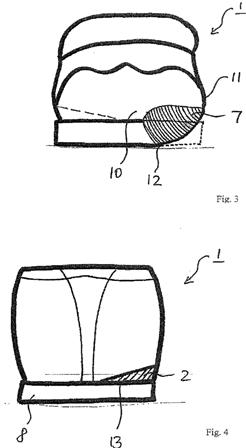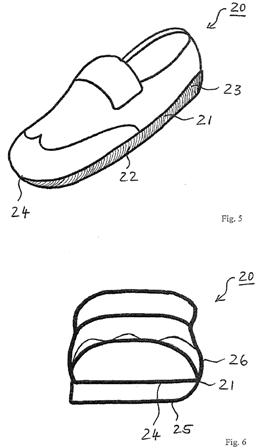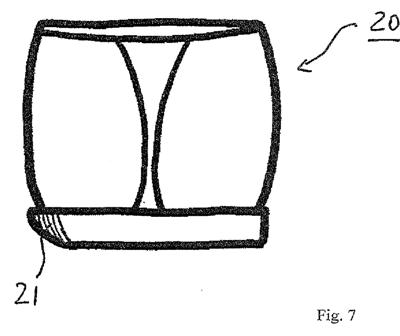Are Your Golf Shoes Holding You Back
As I have said before, interesting golf shoe patent applications do not come along very often. Recently an application that published as US Pub. No. The invention relates to a pair of golf shoes with a rolling surface supporting the swing, wherein an external rolling surface is provided along a shoe outer edge and in the big toe region to the tip region of the other shoe an inner rolling surface is provided along the shoe inner edge.




Seems like a good idea to me. The application goes on to explain:
SUMMARY OF THE INVENTION
[0006] It is the object of the invention to provide an improved pair of golf shoes in which the left and right shoe are formed as an entire system in swing-supporting manner.
[0007] This object is achieved according to the invention by a pair of golf shoes having swing-supporting rolling surfaces according to claim 1. Advantageous embodiments are the subject matter of dependent claims.
[0008] The invention embraces the idea of a pair of golf shoes with swing-supporting rolling surfaces wherein an outer rolling surface is formed on one golf shoe along its outer shoe edge and an inner rolling surface is formed on the other golf shoe in its big toe region as far as into its shoe tip region along the inner shoe edge. The other golf shoe is formed with the aid of an outside foot support having an inwardly inclined foot support surface. An inclination for the inwardly inclined foot support surface in the other golf shoe is different for different foot regions and is greater in a heel region than in a forefoot region. The other golf shoe is further formed with a heel support.
[0009] With the aid of the proposed pair of golf shoes, a shoe system is created which assists and facilitates the movements to be executed as correctly as possibly by the feet of the golfer during the golf swing. Whilst the outer rolling surface facilitates and assists the rolling over the outside of the foot, the inner rolling surface fulfils the same function for the rolling and turning over the tip of the foot to be executed with the other foot. The golf shoes are configured differently, which in this respect can also be described as an “asymmetrically” constructed pair of golf shoes.
[0010] In the case of right-handed persons, the right knee joint is stabilised with the aid of the outside foot support. The other golf shoe thus formed therefore more extensively assists the biomechanically and physically predefined sequence of the golf swing. The inclination of the foot support surface in the other golf shoe can be formed to be continuously increasing from the forefoot region to the heel region. In contrast to this, the golf shoe is designed to be inclination-free. A comparable inclination of the foot support surface is therefore lacking.
[0011] The golf swing comprises a physical process which is implemented biomechanically by the human body. When viewed physically, the swing functions according to the principle of a pendulum that transports an object (golf ball) in a directional manner with the aid of a lever (golf club). Biomechanically a muscular tension is initially built up in the entire body (upswing) by the swinging back of the arms and the turning of the shoulders and the back. In the case of a right-handed person, a shift of weight onto the right leg takes place in this case, which is maximum at the end of the upswing or the energy reversal point (dead point of the pendulum). The now-following pre-swing of the arms brings about a release of the built-up muscular tension and a horizontal rotation of the entire body (through-swing), wherein the left foot remains standing and the right foot turns on its tip. During the pre-swing, a renewed weight shift of weight onto the left leg takes place. At the end of the golf swing of a right-handed person, the entire body weight is therefore located on the left leg.
[0012] For a uniform swing movement it is necessary to maintain the vertical axis of the body during the upswing. The horizontal rotation of the body during the upswing and the shift of weight onto the right leg associated herewith causes a substantial instability factor in the right knee joint. As a result of the rotation-induced right-ward shift of the right knee joint, the risk of leaving the vertical axis arises, which is one of the most frequent problems in executing the golf swing. The turning of the right knee joint to the left which is necessary for initiating the through-swing is impossible due to the previous leaving of the vertical axis. With the left-ward turning of the right knee joint during the through-swing and the renewed horizontal rotation of the body, the right foot also turns on the tip which is another problem zone of the golf swing. Here the inner rolling surface provided now assists the golfer. As a result of the rotation-induced weight shift about the vertical axis, the left foot, when remaining fully on the ground, slides over the outside of the foot onto its outer left edge, where the outer rolling surface has a supporting effect for the golfer.
[0013] The outer rolling surface can be formed over the entire shoe length. However, one configuration can be provided only over a partial region of the shoe outer edge, for example, from the toe region into the heel region wherein the outer rolling surface can stop at the beginning of or before the end of the heel. In combination with this or alternatively to this, it can also be provided that the outer rolling surface does not extend as far as into the toe region but is substantially formed in the rear shoe region as far as the middle shoe region or the beginning of the toe region.
[0014] A preferred embodiment of the invention provides that the inner and the outer rolling surface are each designed to form a surface transition between shoe sole and side shoe surface.
[0015] In a preferred embodiment of the invention, it can be provided that at least one of the rolling surfaces is formed as a rounded rolling surface. The inner or the outer rolling surface or both rolling surfaces can be formed as rounded rolling surfaces, wherein in particular a continuous rounding can be provided to further optimise the swing-induced rolling.
[0016] An advantageous embodiment of the invention provides that at least one of the rolling surfaces is formed with a slope. Both the inner and the outer rolling surfaces or both rolling surfaces can be provided with one or more bevels or slopes. In one embodiment a combination of slope and rounded rolling partial surfaces can also be provided.
Sign me up, I will try a size 10!
David Dawsey – Watching Shoe Patents
PS – click here to check out another interesting golf shoe invention
